| Label |
Label Description |
Images |
| N |
This is a paste-over sticker dating from pre-WWI, used by The
Scottish Record Company of 62 Renfield Street, Glasgow. Investigation
into this by Bill Dean-Myatt (compiler of the Scottish Discography)
could find no record company of this exact name, but at the address
shown in 1908 was The Renfield Street Showrooms, selling pianos and
organs. in 1913, R. Felous Henn Ltd was formed (at this address) with
the purpose of selling music and musical instruments. This would seem a
likely date for these records to be available. This example is pasted
over a "Favorite" record and there is no attempt to
hide the place of manufacture, so it would seem these pre-date the
outbreak of war in 1914. It is not known the significance of "N" for the record label name. Thanks to Ivan Ruddock for providing the label image. |
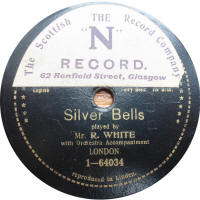 |
| National |
These two different labels styles
date from about the same period, but see also
National Scala Special,
below.
The first one (National Double
Sided) was derived from both Edison Bell master (made in England) and Beka/Lindstrom masters and manufactured in
Germany. It is not known for whom they were produced. See also
"National Scala Special" records below. |
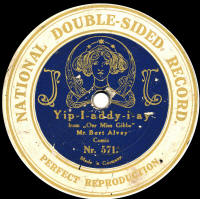 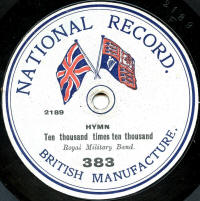 |
| National Gramophonic Society |
This society was formed by Compton
MacKenzie, the founder of The Gramophone magazine, in 1923. The first
records, recorded & made by Columbia, were issued in late 1925.
Subsequent issues were made by Parlophone, Crystalate & Vocalion, many
of the latter being electrically recorded. In 1928, Columbia once more
took up the making until the label and the society were wound up in 1931.
The records at that time were 6/- each. The records had no catalogue numbers to start with, just an alphabetic code, starting, logically, at A, running to Z (but omitting J & U) before continuing from AA, BB, CC up to ZZ, then AAA, BBB and so on, until reaching TTT. From then on they were had conventional catalogue numbers starting from NGS-69, with all the previous issues, when re-pressed, being allocated numbers from NGS-1 to NGS-68. The highest number, issued in Novembr 1931, was NGS-165. Despite the disbanding of the society in 1931, Frank Andrews tells us the electrically-recorded sides were still available until 1962! A full and detailed listing of this label may be found at: National Gramophonic Society discography - Society78sDiscography (nickmorgandiscography.org) Thanks to Bill Dean-Myatt for providing the label image. |
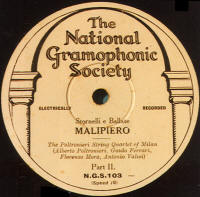 |
| National "Scala Special" |
A Pre-WWI German produced
record using Beka masters. Some copies have a sticker which states
"Scala Special Issue" (see first example) whereas some are blank or have the
copyright stamp (see second example) .
Some have a catalogue number, possibly of the standard Scala issue,
while others just have a letter code, different each side. All issues
seen are by Billy Williams. Please e-mail me with details of ANY of these records. Thanks to Norman Field for providing the first label image. |
_small.jpg) |
| Neglected Masterpieces |
Neglected
Masterpieces were both 10" & 12" in size and date to 1949. They were
made by Oriole Records Ltd. The first few issued used maters from the Classic label in France, but subsequent issues were their own recordings. The records were pressed by Oriole. It is belived there were at least 19 records in the series. Thanks to Bill Dean-Myatt for the label image. |
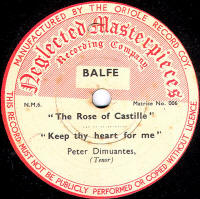 |
| Neophone |
Neophone are believed to
be the first vertical-cut disc on the British market (excepting any
"toy" records) and they appeared in 1904. They were single-sided and
made of cardboard coated with some sort of enamel. It was the invention
of Dr William Michaelis; the groove was U-shaped (like Pathe). There were
many sizes produced from 7˝" to 20" (the latter with a playing time of
nearly 10 minutes). The prices also varied, from 6d to 10/6, depending
on the size. Later on there were some double-sided records made of "Neoline"
which was similar to the standard shellac used for other records. In
1907, record production was taken over by the General Phonograph Co, and
some white records were produced, but production ceased altogether in
1908. Neophone records have never been easy to find, but even so, I've
never seen one, except in collections.
Frank Andrews published an
extensive listing of this label in "Talking Machine Review" in 1978
(issues 51 - 59), which I have transcribed for this site. |
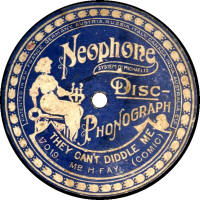 |
| Neptune |
These were produced by
Crystalate for Curwen's, the music publishing company, from 1917 to 1919. The
masters were from Guardsman. They initially cost 2/-, rising to 2/6 in
the autumn of 1918. The catalogue nubers ran from 100 or 101 up to about
276 (the highest found to date). The initial release was intended to be labelled CORONET, but this was challenged by Pathe Freres, as it ws a Pathe registered name. We are told that all CORONET records were recalled and destroyed, but in reality they may never have been manufactered. Or were they, and will one eventually turn up? |
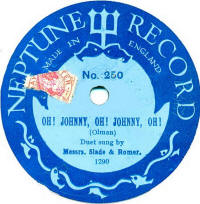 |
| Nestles New Stars |
These were 7" records on a square coloured
background, first sold in 1957. There were 10 different single-sided records initially available from Nestles. To get one you had to send 3 wrappers from Nestle's chocolate bars, a postal order for 1/6 and a coupon. There were later releases (or maybe one more 10-record release), the highest found to date being NR-20. The records were recorded by The Star Sound Studios of Rodmerton Mews, Blandford Street, London W1, and made by The Hardy Record Manufacturing Co, of 62, Oxford Street, London. Frank Andrews notes that at the time, Nestle's were occupying the former buildings of The Universal Music Company, at Hayes Middlesex, where Vocalion records had been made in the 1920s. Thanks to Bill Dean-Myatt for the images. |
 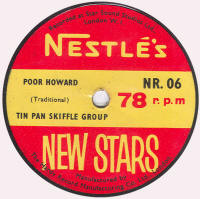 |
| New Bazar | Thanks to Bill Dean-Myatt for the label image. |
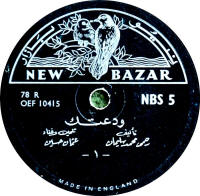 |
| New Electrical Recording |
Frank Andrews reports that these are
Columbia recordings, either issued normally on Columbia or Regal in the
1920s. It looks like an over-stuck label to me, but the significance of
the logo of "AR in a triangle" has not been found yet. The few reported exampl;es are all of organ recordings. Label image from "For The Record" No. 26. |
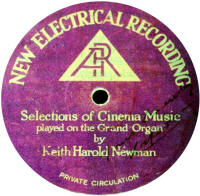 |
| New Empire | see under Empire | |
| New Leader |
This
was the successor to Lansbury's Labour Weekly (q.v.) following the
Lansbury newspaper being absorbed into the Labour Party's official
newspaper. As with the Lansbury label, most record companies refused to
have anything to do with such political matter, and they were pressed by
Pathe with plain white labels, upon which the New Leader labels were
pasted by the party.
Thanks to Bill Dean-Myatt for the label image. |
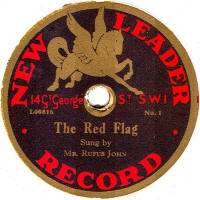 |
| New Star |
This was a label from the private recording company BRS, of
Nottingham. Thanks to Robert Girling for the label image. |
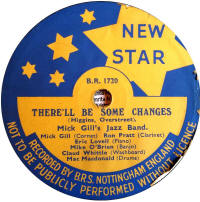 |
| Nicole |
One of
the very earliest disc records, Nicole records were the first to be
manufactured in Britain and were made from a semi-unbreakable material
which looks a bit like linoleum. This was a product of the fledgling
Crystalate Manufacturing Company, whose business was manufacturing in
synthetic materials. The sound is rather rumbly because of
the material, though this wouldn't have been much of an issue when played on
acoustic gramophones of the period. Nicole Freres of Ely Place, Holborn
Circus, London had been musical box manufacturers since 1815, so it was
natural that they should branch out into records. Nicole records were
available in 7" or 10" size and were initially single-sided. In 1906,
the company went into liquidation due to the failure of their main
musical-box business.
A listing of this label was
published in 2001 by Michael Kinnear of Australia. Although the book
itself is now out of print, a pdf version can be purchased from Michael
Kinnear's website at
https://bajakhana.com.au/nicole-record-a-discography/ |
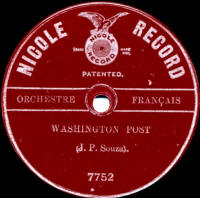 |
| Nigerian Accurate |
These records date to the late 1940s and
early 1950s and were produced by Northern Sound Services of
Newcastle-Upon-Tyne. Thanks to Bill Dean-Myatt for the label image. |
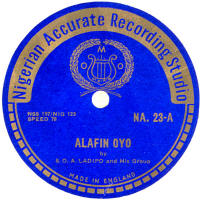 |
| Nixa |
The Nixa Record Company Ltd was established by New Zealander (F H B) Hilton Nixon in 1950, principally to market the catalogue of Compagnie Générale du Disque, Paris (Pacific Records) in Commonwealth of Nations countries. The company was sold to Pye in 1953. Apparently Nixa was second only to Decca in the UK in issuing 33 rpm LPs in the early 50s. They also issued 45rpm EPs, but for 45rpm singles, the name was only used in countries other than the UK. The company address was 6 Holborn Viaduct, London EC1. Information courtesy of Wikipedia. Thanks to Bill Dean-Myatt & Jerry King for the label images. The third image is obviously from after Pye bought the company, but must be an early issue as the Nixa name is in large type and the Pye logo quite small. The label name gradually diminished in size and the logo grew over the next few years. I include it here as an example, though it really belongs under "Pye". |
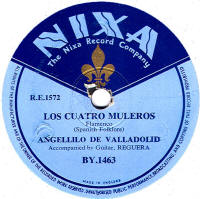 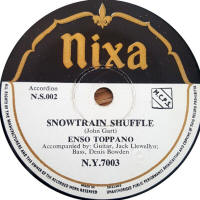 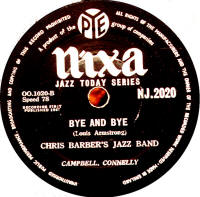 |
| Nursery Record |
This example is actually a "Kid Kord" record, but the label name here is
"Nursery Record". This represents a late pressing, allegedly by Decca, following the 1936 agreement between British Homohpne, EMI & Decca whereby BH agreed to withdraw from producing their own commercial records. Frank says that Decca took on the pressings of Kid-Kord but then later repressed them as seen here with a much plainer label, which must have made them less attractive to theur young audience. Thanks to Bill Dean-Myatt for the label image. |
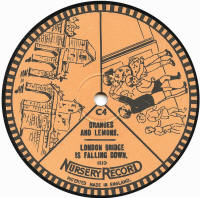 |
| Nursery Rhymes |
A 5˝" (later 6") disc produced by Crystalate to "compete" with the
two "Fairy" labels produced by Edison Bell and Vocalion, Nursery
Rhymes issued just that during a short life in the 1920s. There were no
catalogue numbers as such, each disk was identified by a letter (the one
shown here is "D"). Whether a full 26 discs (or more?) were
issued, I don't know. There was also a Dutch-language series with the same label design, called "Kinderliedjes", also produced by Crystalate at the same period. The same name and label design was used for some 7" discs, again with alphabetic "catalogue numbers". These duplicate the 7" Victory series and will be found on the Victory 7" page. The second image shows a record of a later vintage, manufactured by Oriole, about which I know nothing at present. Thanks to Bill Dean-Myatt for the label image. |
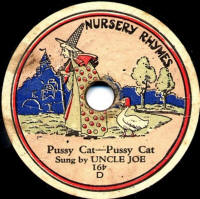 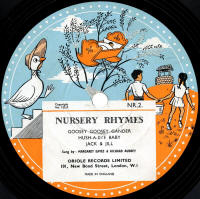 |